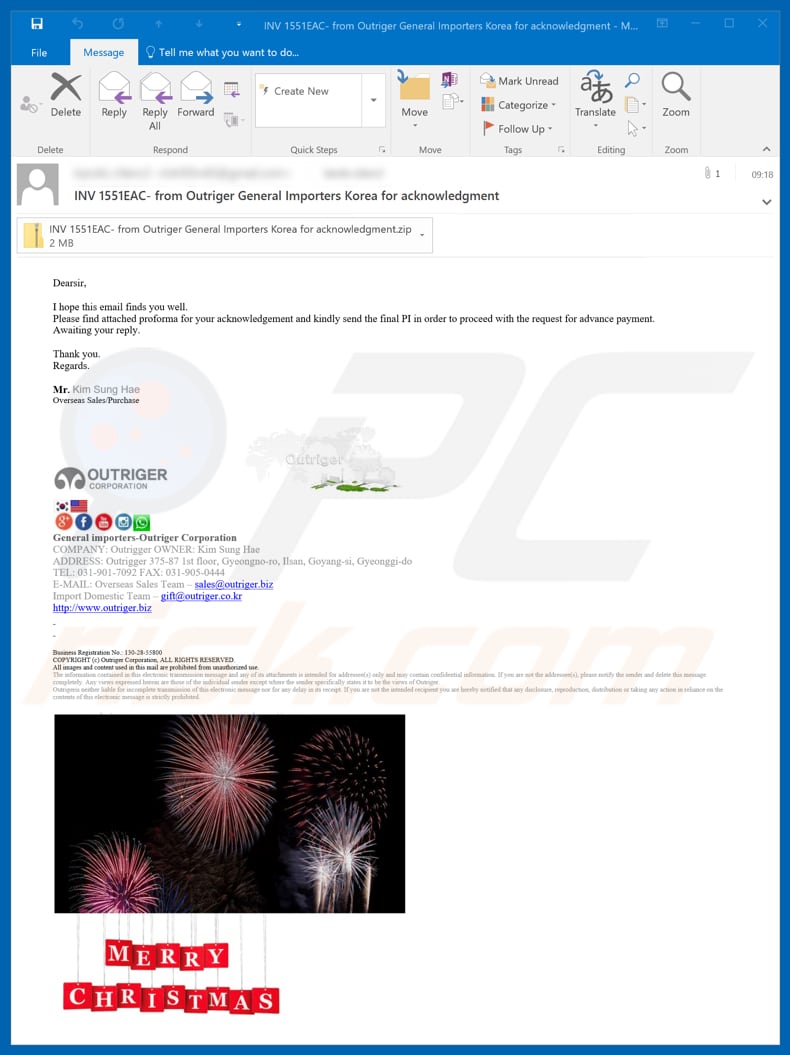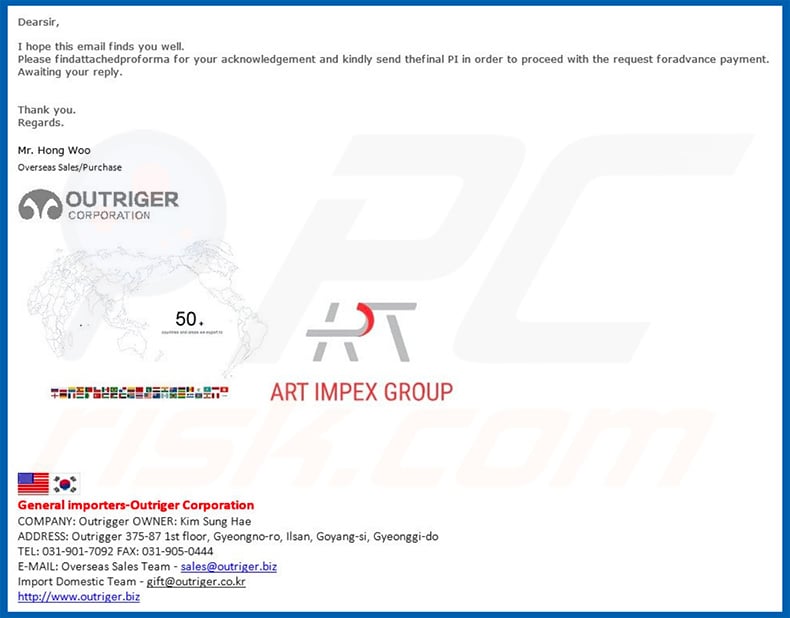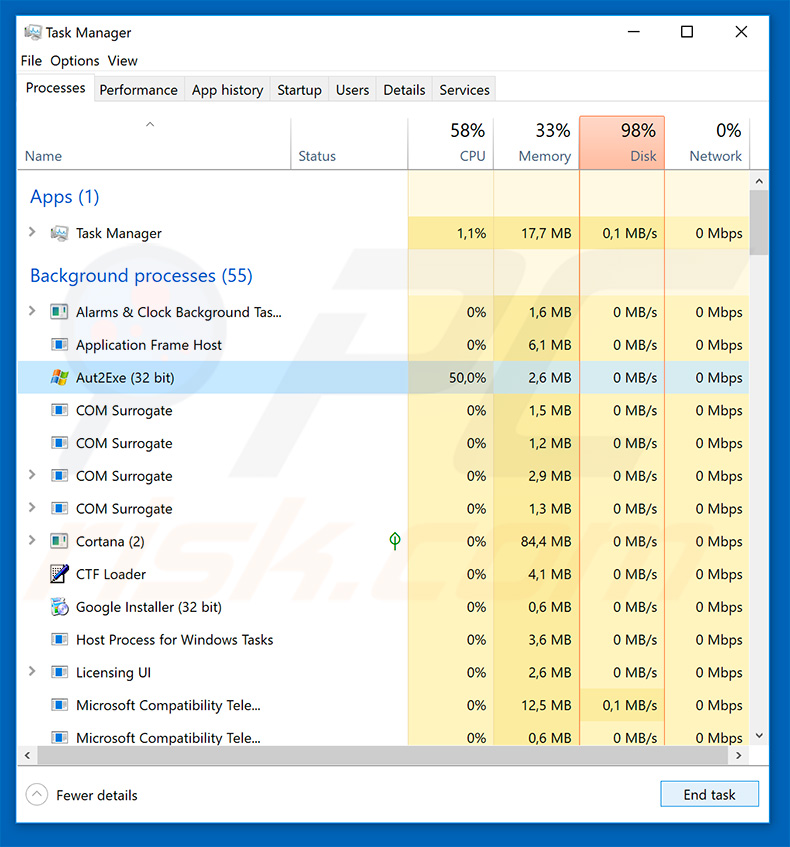Get free scan and check if your device is infected.
Remove it nowTo use full-featured product, you have to purchase a license for Combo Cleaner. Seven days free trial available. Combo Cleaner is owned and operated by RCS LT, the parent company of PCRisk.com.
What is "Outriger Email Virus"?
"Outriger Email Virus" is one of many spam campaigns used by scammers who send emails containing malicious attachments, or web links leading to them. In this case, cyber criminals proliferate an archive file (ZIP), which contains a malicious program called Adwind.
The main purpose of this email scam is to trick users into downloading and installing the virus. We strongly advise that you ignore this and other similar emails (do not open the attachments or web links).

Scammers behind this email claim to be representatives of the Outriger Corporation. They present their scam in an email as a request for advance payment. The email includes an attachment (supposedly an invoice) supposedly within a ZIP archive file. The archive file contains an executable (.EXE) file used to install the aforementioned Adwind malicious program.
Adwind is a trojan-type malicious program that collects various data (including personal information). There are many different versions of this trojan, which is capable of collecting a wide range of data, including keystrokes, saved passwords, and so on. In some cases, it can record audio or video using webcams and microphones.
Typically, the data is misused to generate revenue. For example, recorded passwords might be used to carry out transfers from a victim's bank account, whilst other data might be used for blackmailing purposes, and so on.
Furthermore, trojan-type programs are often programmed to proliferate other computer infections. Therefore, having a virus such as Adwind installed can lead to serious problems.
| Name | Outriger spam |
| Threat Type | Trojan, Password stealing virus, Banking malware, Spyware |
| Symptoms | Trojans are designed to stealthily infiltrate victim's computer and remain silent thus no particular symptoms are clearly visible on an infected machine. |
| Distribution methods | Infected email attachments, malicious online advertisements, social engineering, software cracks. |
| Damage | Stolen banking information, passwords, identity theft, victim's computer added to a botnet. |
| Malware Removal (Windows) |
To eliminate possible malware infections, scan your computer with legitimate antivirus software. Our security researchers recommend using Combo Cleaner. Download Combo CleanerTo use full-featured product, you have to purchase a license for Combo Cleaner. 7 days free trial available. Combo Cleaner is owned and operated by RCS LT, the parent company of PCRisk.com. |
There are many scammers who use different technique. Examples of other similar scams are Christmas Greetings Email Virus, Y.E DESIGN Email Virus, and Christmas Day Bonus Gift Email Virus - these are used to proliferate various computer infections such as FormBook, TrickBot, and Ursnif.
Frequently, these email campaigns are created with just one purpose: to trick people into opening the presented malicious attachment or website link.
How did "Outriger Email Virus" infect my computer?
Scammers who use the "Outriger Email Virus" spam campaign to proliferate the Adwind virus, often trick users into installing the rogue software by presenting an attached ZIP (.zip) archive file. Once extracted, this file contains an executable (.exe) file that installs Adwind.
In other cases, malicious attachments could be Microsoft Office documents, PDF files, other archive files (such as RAR), executable files, and so on.
There are also variants that contain links that, once opened, lead to malicious files. If, for example, the malicious file is an MS Office document, when opened it will ask to enable macro commands. Giving permission to enable these will allow a document to download/install a malicious program.
How to avoid installation of malware?
To avoid infections that are proliferated through spam email campaigns such as the "Outriger Email Virus", we advise you handle emails that contain links or attachments with caution. If you receive an email that was sent from a suspicious or unknown address/sender, or the email seems irrelevant (does not concern you), do not open the presented link or attachment.
Have reputable anti-spyware or anti-virus software installed - these tools can detect and eliminate viruses before they do any harm. If you have already opened a "Outriger Email Virus" attachment, we recommend running a scan with Combo Cleaner Antivirus for Windows to automatically eliminate infiltrated malware.
Text presented in the "Outriger Email Virus" email message:
Dearsir,
I hope this email finds you well.
Please find attached proforma for your acknowledgement and kindly send the final PI in order to proceed with the request for advance payment.
Awaiting your reply.
Thank you.
Regards.
Mr. Kim Sung Hae
Overseas Sales/Purchase
General importers-Outriger Corporation
COMPANY: Outrigger OWNER: Kim Sung Hae
ADDRESS: Outrigger 375-87 1st floor, Gyeongno-ro, Ilsan, Goyang-si, Gyeonggi-do
TEL: 031-901-7092 FAX: 031-905-0444
E-MAIL: Overseas Sales Team – sales@outriger.biz
Import Domestic Team – gift@outriger.co.kr
http://www.outriger.biz
Business Registration No.: 130-28-55800
COPYRIGHT (c) Outriger Corporation, ALL RIGHTS RESERVED.
All images and content used in this mail are prohibited from unauthorized use.
The information contained in this electronic transmission message and any of its attachments is intended for addressee(s) only and may contain confidential information. If you are not the addressee(s), please notify the sender and delete this message completely. Any views expressed herein are those of the individual sender except where the sender specifically states it to be the views of Outriger.
Outrigeris neither liable for incomplete transmission of this electronic message nor for any delay in its receipt. If you are not the intended recipient you are hereby notified that any disclosure, reproduction, distribution or taking any action in reliance on the contents of this electronic message is strictly prohibited.
Another variant of email from Outriger email spam campaign. The malicious attachment is named "INV 3326GHF- from Outriger General Importers Korea for acknowledgment.exe" and it distributes Pony trojan:

Malicious attachment's technical analysis:
- Detection names: Avast (FileRepMalware), BitDefender (Gen:Heur.PonyStealer.5), Kaspersky (UDS:DangerousObject.Multi.Generic)
- Full list of antivirus detections: VirusTotal
- Executable file name: INV 3326GHF- from Outriger General Importers Korea for acknowledgment.exe
- Sample first submitted: 2019-04-01
Text presented within this email:
Dear sir,
I hope this email finds you well. Please find attached pro forma for your acknowledgement and kindly send the final PI in order to proceed with the request for advance payment. Awaiting your reply.
Thank you.
Regards.
Mr. Hong Woo
Overseas Sales/Purchase
OUTRIGER Corporation
Pony's process ("Aut2Exe") in Windows Task Manager:

Instant automatic malware removal:
Manual threat removal might be a lengthy and complicated process that requires advanced IT skills. Combo Cleaner is a professional automatic malware removal tool that is recommended to get rid of malware. Download it by clicking the button below:
DOWNLOAD Combo CleanerBy downloading any software listed on this website you agree to our Privacy Policy and Terms of Use. To use full-featured product, you have to purchase a license for Combo Cleaner. 7 days free trial available. Combo Cleaner is owned and operated by RCS LT, the parent company of PCRisk.com.
Quick menu:
- What is Outriger spam?
- Types of malicious emails.
- How to spot a malicious email?
- What to do if you fell for an email scam?
Types of malicious emails:
![]() Phishing Emails
Phishing Emails
Most commonly, cybercriminals use deceptive emails to trick Internet users into giving away their sensitive private information, for example, login information for various online services, email accounts, or online banking information.
Such attacks are called phishing. In a phishing attack, cybercriminals usually send an email message with some popular service logo (for example, Microsoft, DHL, Amazon, Netflix), create urgency (wrong shipping address, expired password, etc.), and place a link which they hope their potential victims will click on.
After clicking the link presented in such email message, victims are redirected to a fake website that looks identical or extremely similar to the original one. Victims are then asked to enter their password, credit card details, or some other information that gets stolen by cybercriminals.
![]() Emails with Malicious Attachments
Emails with Malicious Attachments
Another popular attack vector is email spam with malicious attachments that infect users' computers with malware. Malicious attachments usually carry trojans that are capable of stealing passwords, banking information, and other sensitive information.
In such attacks, cybercriminals' main goal is to trick their potential victims into opening an infected email attachment. To achieve this goal, email messages usually talk about recently received invoices, faxes, or voice messages.
If a potential victim falls for the lure and opens the attachment, their computers get infected, and cybercriminals can collect a lot of sensitive information.
While it's a more complicated method to steal personal information (spam filters and antivirus programs usually detect such attempts), if successful, cybercriminals can get a much wider array of data and can collect information for a long period of time.
![]() Sextortion Emails
Sextortion Emails
This is a type of phishing. In this case, users receive an email claiming that a cybercriminal could access the webcam of the potential victim and has a video recording of one's masturbation.
To get rid of the video, victims are asked to pay a ransom (usually using Bitcoin or another cryptocurrency). Nevertheless, all of these claims are false - users who receive such emails should ignore and delete them.
How to spot a malicious email?
While cyber criminals try to make their lure emails look trustworthy, here are some things that you should look for when trying to spot a phishing email:
- Check the sender's ("from") email address: Hover your mouse over the "from" address and check if it's legitimate. For example, if you received an email from Microsoft, be sure to check if the email address is @microsoft.com and not something suspicious like @m1crosoft.com, @microsfot.com, @account-security-noreply.com, etc.
- Check for generic greetings: If the greeting in the email is "Dear user", "Dear @youremail.com", "Dear valued customer", this should raise suspiciousness. Most commonly, companies call you by your name. Lack of this information could signal a phishing attempt.
- Check the links in the email: Hover your mouse over the link presented in the email, if the link that appears seems suspicious, don't click it. For example, if you received an email from Microsoft and the link in the email shows that it will go to firebasestorage.googleapis.com/v0... you shouldn't trust it. It's best not to click any links in the emails but to visit the company website that sent you the email in the first place.
- Don't blindly trust email attachments: Most commonly, legitimate companies will ask you to log in to their website and to view any documents there; if you received an email with an attachment, it's a good idea to scan it with an antivirus application. Infected email attachments are a common attack vector used by cybercriminals.
To minimise the risk of opening phishing and malicious emails we recommend using Combo Cleaner Antivirus for Windows.
Example of a spam email:

What to do if you fell for an email scam?
- If you clicked on a link in a phishing email and entered your password - be sure to change your password as soon as possible. Usually, cybercriminals collect stolen credentials and then sell them to other groups that use them for malicious purposes. If you change your password in a timely manner, there's a chance that criminals won't have enough time to do any damage.
- If you entered your credit card information - contact your bank as soon as possible and explain the situation. There's a good chance that you will need to cancel your compromised credit card and get a new one.
- If you see any signs of identity theft - you should immediately contact the Federal Trade Commission. This institution will collect information about your situation and create a personal recovery plan.
- If you opened a malicious attachment - your computer is probably infected, you should scan it with a reputable antivirus application. For this purpose, we recommend using Combo Cleaner Antivirus for Windows.
- Help other Internet users - report phishing emails to Anti-Phishing Working Group, FBI’s Internet Crime Complaint Center, National Fraud Information Center and U.S. Department of Justice.
Share:

Tomas Meskauskas
Expert security researcher, professional malware analyst
I am passionate about computer security and technology. I have an experience of over 10 years working in various companies related to computer technical issue solving and Internet security. I have been working as an author and editor for pcrisk.com since 2010. Follow me on Twitter and LinkedIn to stay informed about the latest online security threats.
PCrisk security portal is brought by a company RCS LT.
Joined forces of security researchers help educate computer users about the latest online security threats. More information about the company RCS LT.
Our malware removal guides are free. However, if you want to support us you can send us a donation.
DonatePCrisk security portal is brought by a company RCS LT.
Joined forces of security researchers help educate computer users about the latest online security threats. More information about the company RCS LT.
Our malware removal guides are free. However, if you want to support us you can send us a donation.
Donate
▼ Show Discussion